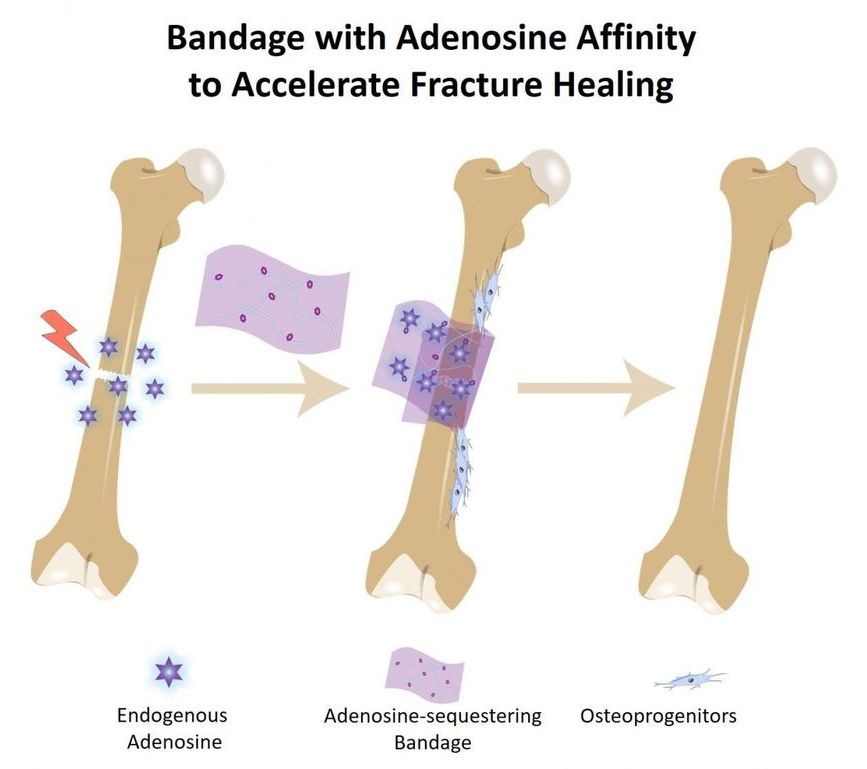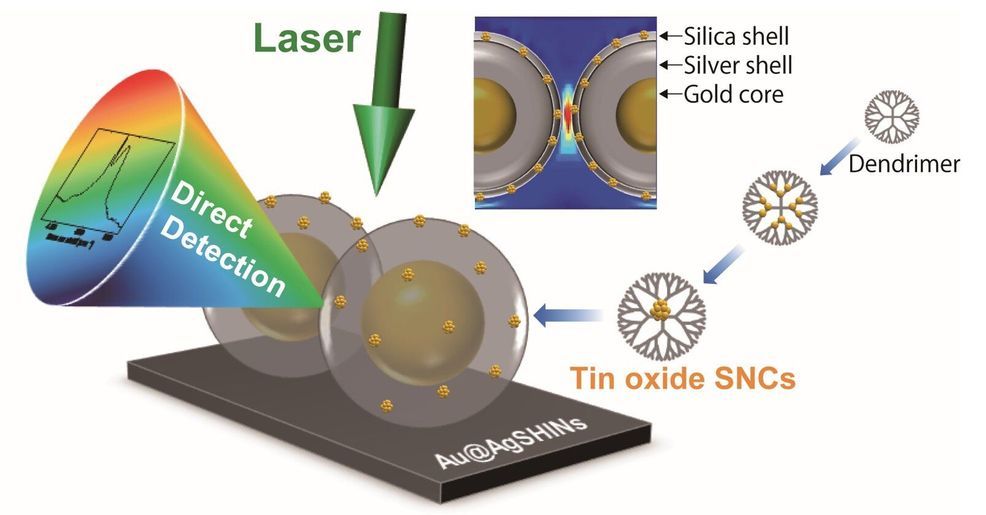Astronomers discover a black hole that shouldn’t exist.
Get the latest international news and world events from around the world.

Bone bandage soaks up pro-healing biochemical to accelerate repair
Researchers at Duke University have engineered a bandage that captures and holds a pro-healing molecule at the site of a bone break to accelerate and improve the natural healing process.
In a proof-of-principle study with mice, the bandage helped to accelerate callus formation and vascularization to achieve better bone repair by three weeks.
The research points toward a general method for improving bone repair after damage that could be applied to medical products such as biodegradable bandages, implant coatings or bone grafts for critical defects.

New methods could help researchers watch neurons compute
Since the 1950s at least, researchers have speculated that the brain is a kind of computer in which neurons make up complex circuits that perform untold numbers of calculations every second. Decades later, neuroscientists know that these brain circuits exist, yet technical limitations have kept most details of their computations out of reach.
Now, neuroscientists reported December 12 in Cell, they may finally be able to reveal what circuits deep in the brain are up to, thanks in large part to a molecule that lights up brighter than ever before in response to subtle electrical changes that neurons use to perform their compuations.
Currently, one of the best ways to track neurons’ electrical activity is with molecules that light up in the presence of calcium ions, a proxy for a neuron spike, the moment when one neuron passes an electrical signal to another. But calcium flows too slowly to catch all the details of a neuron spike, and it doesn’t respond at all to the subtle electrical changes that lead up to a spike. (One alternative is to implant electrodes, but those implants ultimately damage neurons, and it isn’t practical to place electrodes in more than a handful of neurons at once in living animals.)
Scientists explain why some molecules spontaneously arrange themselves into five slices of nanoscale pie
Materials formed on vanishingly small scales are being used in medicine, electronics, manufacturing and a host of other applications. But scientists have only scratched the surface of understanding how to control building blocks on the nanoscale, where simple machines the size of a virus operate.
Now, a team of researchers led by Dongsheng Li, a materials scientist at PNNL, and collaborators at the University of Michigan and the Chinese Academy of Sciences, have unlocked the secret to one of the most useful nanostructures: the five-fold twin. Their study describing why and how this shape forms is detailed in the journal Science and was presented at the Materials Research Society annual meeting on December 5, 2019.
A cross section of a five-fold twin structure looks for all the world like a pie sliced into five perfectly symmetrical pieces. Nanomaterials with this structure have already been shown to have useful properties and are deployed in medical research for precisely tagging cancerous tumors for imaging and tracking, and in electronics, where they are valued for their mechanical strength.

Nanoscience breakthrough: Probing particles smaller than a billionth of a meter
Scientists at Tokyo Institute of Technology (Tokyo Tech) have developed a new methodology that allows researchers to assess the chemical composition and structure of metallic particles with a diameter of only 0.5 to 2 nm. This breakthrough in analytical techniques will enable the development and application of minuscule materials in the fields of electronics, biomedicine, chemistry, and more.
The study and development of novel materials have enabled countless technological breakthroughs and are essential across most fields of science, from medicine and bioengineering to cutting-edge electronics. The rational design and analysis of innovative materials at nanoscopic scales allows us to push through the limits of previous devices and methodologies to reach unprecedented levels of efficiency and new capabilities. Such is the case for metal nanoparticles, which are currently in the spotlight of modern research because of their myriad potential applications. A recently developed synthesis method using dendrimer molecules as a template allows researchers to create metallic nanocrystals with diameters of 0.5 to 2 nm (billionths of a meter).
Can We Apply Human Ethics to Robots?
Who is responsible when a robot harms a human? Robot ethics tackle this and other interesting robot issues.
Technological Singularity — Artificial Intelligence (AI)
Human intelligence is not linear. Machine intelligence can be summed up in three words; efficiency, efficacy and trade off. The more we automate human thinking, the less we need humans. Get it?
From the subtle advancements in technology to the birth of SKYNET!!!! Join us as we explore facts about the Technological Singularity.
11. What is the Technological Singularity?
What’s that? You don’t know what it is? No worries, it is a pretty scientific term.
To quote Wikipedia, the Technological Singularity, “is a hypothetical future point in time at which technological growth becomes uncontrollable and irreversible, resulting in unfathomable changes to human civilization.“
What’s more, this is NOT a new theory or idea. And it honestly wasn’t proposed by various sci-fi movies. In fact, it was proposed by a book in 1993 via Vernor Vinge in The Coming Technological Singularity. What’s more, while this may seem like a “sci-fi future”, there are many who actually believe that not only will this come, but it could come to bear as soon as 2050.
10. Where Are We Now In The Technological Singularity?
To fully understand how the Technological Singularity could happen, we need to understand where we are as a society that could lead us to the Technological Singularity future that many fear.
9. Intelligence Boom
The key word here to note is “IntelligenceBoom”. No, I don’t mean like our own brains exploding (that would be bad…), but rather, an boom of potential via Artificial Intelligence. This is one of the potential “outcomes” of a Technological Singularity.
Think of it like this. Every generation of computer we make is technically better than the next, right? The difference between what we do and what an Intelligence Boom is, is that the A.I. is the one “making” the next generation. That’s a scary thought, huh? And that’s actually a reason why many are opposed to the research on super-intelligent (and always evolving) A.I’s. This included the late Stephen Hawking and current eccentric Billionaire Elon Musk. They feel that humanity will be doomed because of A.I’s. Whether it be through Intelligence Boom, or something of our own making.
8. Making A “Better Tomorrow“
There is another way that many dispute the Technological Singularity will come via A.I. and that’s simply by creating an A.I. ourselves that goes far beyond what we intended it to be. Which may not be as far-fetched as you might think.
If I were to say the names Alexa, Siri, and Watson, you’d recognize them as various machines with various intelligence, right? Well technically, they’re all A.I., just with different levels of intelligence. Siri came first and could react to certain things on your iPad or iPhone. Some think that we are very close to that point. Including a man named Ray Kurzweil, who believes that we could be at the Singularity point by 2045 at the earliest.
7. The Predictions Of Ray Kurzweil Part 1
If you’re not familiar with ray kurzweil, you honestly should read up on him, he’s not just another guy predicting the end of civilization, he’s actually an engineer at Google, and sees himself as a Futurist. One who has made predictions in the past about technologies advances with accuracy.
6. Robotics
When you think of the “future” that humanity “wants” and that various sci-fi and movies have “predicted”, the obvious things you see are robots and people with robotic appendages. Let’s look at robots first. The Technological Singularity notes that as robots get more advanced, humans will become less and less important. All part of the “A.I. Overlord” scenarios if you will. Then again, WE could be the robots, not unlike another robotic race with brilliant intelligence: The Borg.
5. Artificial Limbs and Cyborgs
One of the biggest and most worrying things about a person in regards to their life is the chance that they could lose a limb. The loss of a limb is something that cannot be overcome simply.
4. The Predictions Of Ray Kurzweil Part 2 ( ray kurzweil 2019)
But again, the question becomes, “How far are we from that future?” If Ray Kurzweil is to be believed, not as far as you think. For he believes a key part of the singularity will come in 2029, a mere decade in the future.
3. 2049
By 2049, humanity has become so intertwined with technology that it’s hard to tell what’s real, and what’s not. For example, there are machines in this time period according to Kurzweil that can literally make just about anything the user wants. They’re called Foglets, and they literally are around every person on Earth. They can make food so good you’ll swear it’s “natural” even though it’s not.
2. Skynet
Yep, that’s the “nuclear option”. The notion that we as humans make a technology or intelligence so powerful that it realizes one day that humanity…is actually inferior to it. To which, it’ll go to extreme lengths in order to make sure that humanity is wiped off the face of the Earth.
1. Will The Technological Singularity Happen?
That is the question, isn’t it? is Judgment Day inevitable?

Japan Aims For An Air Mobility Revolution With Flying Taxis And Mobility As A Service
In 1893, Japanese entrepreneur Kokichi Mikimoto succeeded in creating the world’s first cultured pearls in the coastal city of Toba, Mie Prefecture. Mikimoto changed the world of jewelry and launched a new industry. Today, steps away from the island where Mikimoto created the pearls, Toba is aiming to launch another new industry: flying taxis to offshore settlements. Earlier this year, NEC showed off its eVTOL flying car concept, which hovered 3 meters off the ground for about a minute. These developments are part of a global push to develop autonomous aircraft that could become a $1.5 trillion market by 2040, according to Morgan Stanley Research.

It’s Official: NASA Is Considering an Interstellar Mission
It could represent “humanity’s first explicit step into interstellar space,” as team member at the Applied Physics Laboratory Pontus Brandt told Wired, years after Voyager 1 became the first-ever human-built spacecraft to reach interstellar space.
Rocket Plan
The basic outline of their proposal, which arose out of a NASA supported interstellar probe study last year, is to launch a spacecraft that weighs less than 1,700 pounds on NASA’s upcoming — but much delayed and over budget — Space Launch System rocket.
Humans are genetically hardwired to only live for 38 YEARS
Humans have a maximum natural lifespan of only 38 years, according to researchers, who have discovered a way to estimate how long a species lives based on its DNA.
Scientists at Australia’s national science agency have developed a genetic ‘clock’ computer model that they claim can accurately estimate how long different vertebrates are likely to survive — including both living and extinct species.
Using the human genome, the researchers found that the maximum natural lifespan of humans is 38 years, which matches anthropological estimates of lifespan in early modern humans.